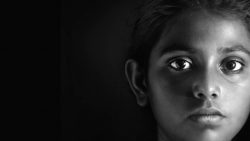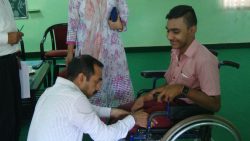
Our Little Charms
Make donation for upcoming projects for improvement of school infrastructure, treatment & therapies. S/NO STUDENT NAME FATHER NAME DOB DOA...
In today’s scenario, being a world of rat race, we don’t realise the pressures our kids are under. We as parents ignore the symptoms that our kid is special putting lots of hurdles in the path of existence of the child.
So to enlighten on different kinds of disabilities, following are brief given:-
Autism is a distinct brain damage disorder that produces a characteristic range of behavioral abnormalities.
AUTISM is a severely incapacitating lifelong developmental disability that typically appears during the first three years of life. It occurs in approximately one out of every 150 births and is more common in boys than girls. It has been found throughout the world in families of all racial, ethnic and social backgrounds. No known factors in the psychological environment of a child have been shown to cause autism. The symptoms are caused by physical disorders of the brain.
They include:
This means that in a classroom of 25 to 30 children, it is likely that at least one will have ADHD.ADHD was first described by Dr. Heinrich Hoffman in 1845. A physician who wrote books on medicine and psychiatry, Dr. Hoffman was also a poet who became interested in writing for children when he couldn’t find suitable materials to read to his 3-year-old son. The result was a book of poems, complete with illustrations, about children and their characteristics. “The Story of Fidgety Philip” was an accurate description of a little boy who had attention deficit hyperactivity disorder. Yet it was not until 1902 that Sir George F. Still published a series of lectures to the Royal College of Physicians in England in which he described a group of impulsive children with significant behavioral problems, caused by a genetic dysfunction and not by poor child rearing—children who today would be easily recognized as having ADHD.1 Since then, several thousand scientific papers on the disorder have been published, providing information on its nature, course, causes, impairments, and treatments. A child with ADHD faces a difficult but not insurmountable task ahead. In order to achieve his or her full potential, he or she should receive help, guidance, and understanding from parents, guidance counselors, and the public education system. This document offers information on ADHD and its management, including research on medications and behavioral interventions, as well as helpful resources on educational options.Because ADHD often continues into adulthood, this document contains a section on the diagnosis and treatment of ADHD in adults
Asperger syndrome (AS) is a developmental disorder. It is an autism spectrum disorder (ASD), one of a distinct group of neurological conditions characterized by a greater or lesser degree of impairment in language and communication skills, as well as repetitive or restrictive patterns of thought and behaviour. Other ASDs include: classic autism, Rett syndrome, childhood disintegrative disorder, and pervasive developmental disorder not otherwise specified (usually referred to as PDD-NOS). Unlike children with autism, children with AS retain their early language skills.
The most distinguishing symptom of AS is a child’s obsessive interest in a single object or topic to the exclusion of any other. Children with AS want to know everything about their topic of interest and their conversations with others will be about little else. Their expertise, high level of vocabulary, and formal speech patterns make them seem like little professors. Other characteristics of AS include repetitive routines or rituals; peculiarities in speech and language; socially and emotionally inappropriate behaviour and the inability to interact successfully with peers; problems with non-verbal communication; and clumsy and uncoordinated motor movements.<?p>
A: Down syndrome is a mental retardation syndrome caused by a chromosomal problem that occurs at conception. Down Syndrome is the most frequently occurring chromosomal abnormality, occurring once in approximately every 800 to 1,000 live births. Over 350,000 people in the United States have Down Syndrome. Down Syndrome is usually caused by an error in cell division called non-disjunction. People with Down Syndrome have an extra, critical portion of the number 21 chromosome present in all, or some, of their cells. This additional genetic material alters the course of development and causes the characteristics associated with the syndrome. Most people with Down Syndrome have some level of mental retardation; however, the level usually falls into the mild to moderate range and is not indicative of the many strengths and talents that each individual possesses. Children with Down Syndrome learn to sit, walk, talk, play, toilet, train and do most other activities only somewhat later than their peers without Down Syndrome.
Early intervention services, which begin shortly after birth, help children with Down Syndrome develop to their full potential. Quality educational programs, along with a stimulating home environment and good medical care enable people with Down Syndrome to become contributing members of their families and communities.
A: Chromosomes are thread-like structures found in all the cells of our bodies which determine all of our physical characteristics. Chromosomes are composed of genes which contain the material that determines hereditary characteristics and direct all our body functions. Human cells normally contain 23 pairs of chromosomes for a total of 46. Usually one member of each chromosome pair is contributed at conception when each parent-to-be provides reproductive cells (egg and sperm), each containing 23 chromosomes.
At conception, the mother’s egg and the father’s sperm unite to form a fertilized egg resulting in 46 chromosomes. The first cell goes on to divide to form new cells. These new cells undergo a continuous series of divisions, eventually giving rise to all the cells necessary to form a new human being. After birth, a blood sample is taken from a baby suspected of having Down syndrome for chromosomal analysis.

Make donation for upcoming projects for improvement of school infrastructure, treatment & therapies. S/NO STUDENT NAME FATHER NAME DOB DOA...
E-Saadhya & SWAR 1. e-Saadhya (a.) e-Saadhya is an education framework for children with autism and mild mental retardation. As part of...
CURRICULUM 2022-23 CATEGORY CLASSES FROM 0830 HRS TO 1230 HRS Pre Primary A Prayer & Exercise Personal Skills, Basic Needs, Color & Shape Motor...

Learning about the disabilities is important but not knowing on how to eliminate them, deprives the child of all happiness in the world. We, in...